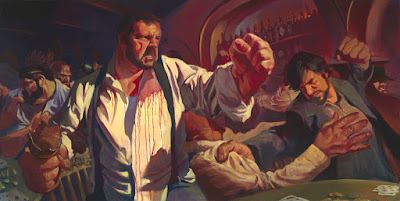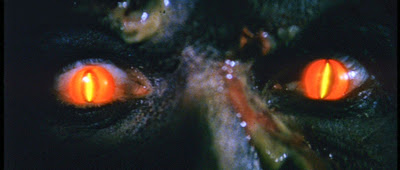I am not trying to step on
+Arnold K. here whatsoever. Go and read his Sphere Wizards and use them and then tell him you used them and how that went.
This is for a....different perspective.
They are not spheres who are wizards. They are being who become wizards by being spheres.
The Koreshanians
When you spend sometimes decade in study, unlocking the esoterica of the planes, you normally increase in power and understanding, slowly, until as a wizard you are practically a different creature, as removed from man as man from rat. Mostly, this is a matter of a shift in fundamental perspective.
Some people approach cosmic power in the other direction: achieving the perspective, and allowing the power to follow. These are called sphere wizards, and their eyes are opened using time drugs.
These wizards leave behind their corporeal form and become a part of the fundamental universe. This makes the universe itch like crazy and try to dig the wizard out with a rusted sharp spoon, but for the man who becomes the sphere wizard...
From their perspective, they are within the central point of the known world, as it curves around and over them. They sky is above them and within the curve. It is the perspective of an ancient or an idiot spread across space so that everywhere you look is everything.
They exist as points of energy. In lower planes they may appear as a circle or wheel, and in higher planes they may seem as a 3-sphere or cylinder. In the normal world, however, they resemble large balls, about the size of one of those sex balls or pilates balls and why did I write sex balls first??? The wizard is within the sphere, or it's better to say they are the inside of the spheres. What you see in the 3d world, the sphere, is merely the interface point of a part of the universe
amongst itself. Sphere wizards are masturbation but then aren't all wizards?
They move by means of relative manipulation, locomoting their position in the universe. Typically they will attach their gravity to another ally and slightly orbit. They affect the world by reaching through their interface point - the sphere - and imposing their energy on the energy of the world surrounding that interface. (Remember they aren't omnipresent or omniscient, merely a part of everything/a part in everything. They can only control their bodies, but affect themselves in creatures and objects.)
From their perspective, they are reaching out and down into a point in the world and manipulating it, pushing this influence out through the point in space they have deigned to interface with.
They don't have AC as such. They basically have their Intelligence as AC ascending/every point above 9 as a negative modifier for descending for the sphere, since they cannot be touched in another manner. Attacks must focus on the surface of the interface, on the "funnel" to a point in space which is also every point in space. The more abstracted damage the sphere takes, the more stress is put on the overmind of the sphere wizard, and the less likely they are to maintain their form. AC roughly equates then to the strength of the Sphere Wizard's focus, and damage to that focus is a grounding element that ties them closer to the physical plane like a lightning rod.
At 0HP, the sphere shatters, which means that the sphere inverts, which means that the universe ripples a little and the wizard becomes corporeal again. They do not return to human form; rather, their one-with-all being manifests in a physical form. One accustomed to not needing oxygen, and not needing to withstand normal atmospheric pressure, and they will then race themselves to see if their tissues disintegrate before they suffocate. Often they drown in gallons of the effort of their breath.
HD: d6
Saves: as Magic-User
Attacks: as Magic-User
Advances: as Magic-User
Requirements: Intelligence 12 or lower (because the smart guys are too smart to take the easy way out just because it sounds more sexy and powerful).
- Each round, a Sphere Wizard can do three things: move its interface in relation to another part of itself, observe, and manipulate a mundane object as if the sphere had invisible hands. It cannot do this with enough facility to wield a weapon.
- Sphere Wizards can see everything within 360 degree squared, though it takes effort to focus on it all and limit their sight in order to understand part of the world/themselves.
- A Sphere Wizard's reach for manipulation is its Intelligence in feet or meters or whatever. It may attempt to affect a worn/possessed item, using its Wisdom for anything that would normally be a Dexterity or Strength test. This reach increases 1' each level.
- Sphere Wizards are roughly 3.5' across and float about 3' above the ground.
- A Sphere Wizard has a series of abilities called Perspectives. Each level it becomes capable of achieving a new Perspective, corresponding to level number reached. It may effect as many Perspectives as it can so long as the total level requirement for unlocking each Perspective does not exceed the Sphere Wizard's current level.
- A Sphere Wizard collects "spell slots" like a normal Magic User but do not gain SPELLS like Magic-Users. They can, however, learn spells in the course of play (from another player or by finding a spellbook).
- They can manipulate as many objects at a time as it has spell slots, but may only use one of these to practical effect each round. High level Sphere Wizards have deadly orbits.
- A Sphere Wizard is proficient with no weapons or armor, but it may successfully manipulate an object as a "wielded" projectile for 1d4+Wisdom bonus damage.
- A Sphere Wizard may know any number of languages it chooses, being everywhere and everything. However, the Sphere Wizard may only communicate a number of words at a time equal to its level.
- At 3rd level, a Sphere Wizard observing through its lens can see all invisible creatures as well.
- At 5th level, a Sphere Wizard may also use its spell slots to recharge magical objects, imparting the power cosmic.
- At 9th level, a Sphere Wizard's interface lens becomes charged with magical energy, like ball lightning. Touching the membrane between the real world (the wizard's inner concave world) and the abstraction of the world (the perceived sphere) delivers a powerful shock, 2d6, as does touching it with a conductive item like a weapon. They also gain the power to cast the Sphere Wizard spell on a willing participant, turning any willing character into a Sphere Wizard level 0 in their service. This is a one way ticket though, fellas.
- At 13th level, a Sphere Wizard is also always aware of the presence of any dead and restless spirits in the vicinity of its interface, and it can communicate with them, because both time and death are an illusion.
- Sphere Wizards may advance to level 16.
Remember that it is possible that none of the above is.....strictly true. That the sphere wizard manifestation is a long range projection of some Magic-Users tripping ass-to-balls on some powwwerful shit. That when this connection is disrupted it pulls some innocent being to our world to die, while hemorrhaging the MU's brain. That there be a sunflower forest somewhere filled with dead Magic-Users. This is possible.
This is likely.
Perspectives
- You may conduct an additional manipulation or observation each round for 1d4 rounds.
- You can perfectly recall anything from the current session; that is, you invoke a hint from the DM, that must be delivered concisely and in clear, unambigious language.
- You wobble and the world hurts, and something in the world exists less than it did before. A target within your reach (above) takes 1d6+1+Wisdom modifier in damage.
- Your "globe" displays one of your memories, perfectly, for 30 seconds. Anyone viewing you sees this memory perfectly from their perspective, no matter what that is.
- You may hide your presence, becoming a thin pin-prick of light imperceptible except on like an amazing roll (like 100 on two different d100 rolls) for a number of minutes equal to your level.
- Every creature who can see you who is within your range of effect experiences the damage described in 3.
- You may exist in 3 points simultaneously, dividing your normal abilities and Perspectives between them.
- You heal yourself your Intelligence in hit points.
- You take on all the normal capabilities of a Downball.
- You may create a false shadow of yourself, a Bubble Buddy. This Bubble Buddy orbits alongside and around you but does not act. If you are hit, you can always elect to have that hit make contact with your Bubble Buddy. If you are crit, or if you roll a 1, your Bubble Buddy always pops. You may only have as many Bubble Buddies active as members of your party, one BB orbiting around each.
- Your 'surface' turns black and a wave spreads out from you, dark light. 10d6 damage to all living creatures.
- Your entireness absorbs the souls of any creatures you kill. Keep track of who you absorb. From now on, once per day, you may know one thing that each soul within you knew (Ask the DM a question they could answer). You also roll the creatures' HD and heal that many HP at time of absorption.
- You gain the freedom of full flight, e.g. you won't float down a pit to your doom, for a day.
- Any amount of spells and spell slots may be invested in you by other Magic-Users for the duration of a day.
- In the event that you are killed, you reappear in your position from 10 minutes previous with 1HP and 0 remaining Perspectives.
- Your interface may change between a sphere and a form resembling your old mortal shape, but with a glasslike translucence and filled with stars. You may switch between the two at will after invoking this ability. In your Sphere Wizard form, you have all your normal Sphere Wizard abilities. In your mortal shadow form, you possess all the abilities of a normal Magic-User 1/4 your level, including the ability to wield weapons, use magic items like rings and clothes, cast from scrolls, etc. You are 2 points easier to hit in this form.









